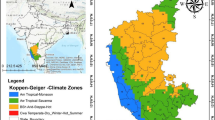Abstract
This study designed an approach to derive land-cover in the South Africa with insufficient ground samples, and made a case demonstration in Nzhelele and Levhuvu catchments, South Africa. The method was developed based on an integration of Landsat 8, Sentinel-1, and Shuttle Radar Topography Mission (SRTM) Digital Elevation Model (DEM), and the Google Earth Engine (GEE) platform. Random forest classifier with 300 trees is employed as land-cover classification model. In order to overcome the defect of insufficient ground data, the stratified sampling method was used to generate the training and validation samples from the existing land-cover product. Likewise, in order to recognize different land-cover categories, the percentile and monthly median composites were employed to expand input metrics of random forest classifier. Results showed that the overall accuracy of the land-cover of Nzhelele and Levhuvu catchments, South Africa in 2017–2018 reached to 76.43%. Three important results can be drawn from our research. 1) The participation of Sentinel-1 data can slightly improve overall accuracy of land-cover while its contribution on land-cover classification varied with land types. 2) Under-fitting problem was observed in the training of non-dominant land-cover categories using the random sampling, the stratified sampling method is recommended to make sure the classification accuracy of non-dominant classes. 3) When related reflectance bands participated in the training process, individual Normalized Difference Vegetation index (NDVI), Enhanced Vegetation Index (EVI), Soil Adjusted Vegetation Index (SAVI), Normalized Difference Built-up Index (NDBI) have little effect on final land-cover classification result.
Similar content being viewed by others
References
Arino O, Gross D, Ranera F et al., 2007. GlobCover: ESA service for global land cover from MERIS. In 2007 IEEE International Geoscience and Remote Sensing Symposium, 2412–2415.
Breiman L, 2001. Random Forests. Machine Learning, 45(1): 5–32. doi: https://doi.org/10.1023/A:1010933404324
Chen B, Xiao X, Li X et al., 2017. A mangrove forest map of China in 2015: analysis of time series Landsat 7/8 and Sentinel-1A imagery in Google Earth Engine cloud computing platform. ISPRS Journal of Photogrammetry and Remote Sensing, 131: 104–120. doi:https://doi.org/10.1016/j.isprsjprs.2017.07.011
Chen J, Chen J, Liao A et al., 2015. Global land cover mapping at 30m resolution: a POK-based operational approach. ISPRS Journal of Photogrammetry and Remote Sensing, 103: 7–27. doi: https://doi.org/10.1016/jisprsjprs.2014.09.002
Dong J, Xiao X, Menarguez M A et al., 2016. Mapping paddy rice planting area in northeastern Asia with Landsat 8 images, phenology-based algorithm and Google Earth Engine. Remote Sensing of Environment, 185: 142–154. doi: https://doi.org/10.1016/j.rse.2016.02.016
Friedl M A, McIver D K, Hodges J C F et al., 2002. Global land cover mapping from MODIS: algorithms and early results. Remote Sensing of Environment, 83(1): 287–302. doi: https://doi.org/10.1016/S0034-4257(02)00078-0
Funk C, Peterson P, Landsfeld M et al., 2015. The climate hazards infrared precipitation with stations—a new environmental record for monitoring extremes. Scientific Data, 2(1): 150066. doi: https://doi.org/10.1038/sdata.2015.66
Gong P, Liu H, Zhang M et al., 2019. Stable classification with limited sample: transferring a 30-m resolution sample set collected in 2015 to mapping 10-m resolution global land cover in 2017. Science Bulletin, 64(2095–9273): 370–373. doi:https://doi.org/10.1016/j.scib.2019.03.002
Gong P, Wang J, Yu L et al., 2013. Finer resolution observation and monitoring of global land cover: first mapping results with Landsat TM and ETM+ data. International Journal of Remote Sensing, 34(7): 2607–2654. doi: https://doi.org/10.1080/01431161.2012.748992
Gorelick N, Hancher M, Dixon M et al., 2017. Google Earth Engine: planetary-scale geospatial analysis for everyone. Remote Sensing of Environment, 202: 18–27. doi:https://doi.org/10.1016/j.rse.2017.06.031
Hansen M C, Potapov P V, Moore R et al., 2013. High-Resolution Global Maps of 21st-Century Forest Cover Change. Science, 342(6160): 850. doi: https://doi.org/10.1126/science.1244693
Huete A, Didan K, Miura T et al., 2002. Overview of the radiometric and biophysical performance of the MODIS vegetation indices. Remote Sensing of Environment, 83(1): 195–213. doi:https://doi.org/10.1016/S0034-4257(02)00096-2
Huete A R, 1988. A soil-adjusted vegetation index (SAVI). Remote Sensing of Environment, 25(3): 295–309. doi:https://doi.org/10.1016/0034-4257(88)90106-X
Huete A R, Liu H Q, Batchily K et al., 1997. A comparison of vegetation indices over a global set of TM images for EOS-MODIS. Remote Sensing of Environment, 59(3): 440–451. doi:https://doi.org/10.1016/S0034-4257(96)00112-5
Li W, Fu H, Yu L et al., 2016. Stacked Autoencoder-based deep learning for remote-sensing image classification: a case study of African land-cover mapping. International Journal of Remote Sensing, 37(23): 5632–5646. doi: https://doi.org/10.1080/01431161.2016.1246775
Liu H Q, Huete A, 1995. A feedback based modification of the NDVI to minimize canopy background and atmospheric noise. IEEE Transactions on Geoscience and Remote Sensing, 33(2): 457–465. doi: https://doi.org/10.1109/TGRS.1995.8746027
Makungo R, Odiyo J O, Ndiritu J G et al., 2010. Rainfall-runoff modelling approach for ungauged catchments: a case study of Nzhelele River sub-quaternary catchment. Physics and Chemistry of the Earth, Parts A/B/C, 35(13): 596–607. doi:https://doi.org/10.1016/j.pce.2010.08.001
McFeeters S K, 1996. The use of the Normalized Difference Water Index (NDWI) in the delineation of open water features. International Journal of Remote Sensing, 17(7): 1425–1432. doi: https://doi.org/10.1080/01431169608948714
Miller J D, Thode A E, 2007. Quantifying burn severity in a heterogeneous landscape with a relative version of the delta Normalized Burn Ratio (dNBR). Remote Sensing of Environment, 109(1): 66–80. doi:https://doi.org/10.1016/j.rse.2006.12.006
Pekel J F, Cottam A, Gorelick N et al., 2016. High-resolution mapping of global surface water and its long-term changes. Nature, 540: 418. doi: https://doi.org/10.1038/nature20584
Pesaresi M, Ehrlich D, Ferri S et al., 2016. Operating procedure for the production of the Global Human Settlement Layer from Landsat data of the epochs 1975, 1990, 2000, and 2014. Publications Office of the European Union, 1–62.
Savitzky A, Golay M J E, 1964. Smoothing and differentiation of data by simplified least squares procedures. Analytical Chemistry, 36(8): 1627–1639. doi: https://doi.org/10.1021/ac60214a047
Singha M, Dong J, Zhang G et al., 2019. High resolution paddy rice maps in cloud-prone Bangladesh and Northeast India using Sentinel-1 data. Scientific data, 6(1): 1–10. doi: https://doi.org/10.1038/s41597-019-0036-3
Tian F, Wu B, Zeng H et al., 2019. Efficientidentification of corn cultivation area with multitemporal Synthetic Aperture Radar and optical images in the Google Earth Engine Cloud Platform. Remote Sensing, 11(6). doi: https://doi.org/10.3390/rs11060629
Tucker C J, 1979. Red and photographic infrared linear combinations for monitoring vegetation. Remote Sensing of Environment, 8(2): 127–150. doi:https://doi.org/10.1016/0034-4257(79)90013-0
Wang J, Zhao Y, Li C et al., 2015. Mapping global land cover in 2001 and 2010 with spatial-temporal consistency at 250m resolution. ISPRS Journal of Photogrammetry and Remote Sensing, 103: 38–47. doi:https://doi.org/10.1016/j.isprsjprs.2014.03.007
Xiong J, Thenkabail P S, Gumma M K et al., 2017. Automated cropland mapping of continental Africa using Google Earth Engine cloud computing. ISPRS Journal of Photogrammetry and Remote Sensing, 126: 225–244. doi:https://doi.org/10.1016/j.isprsjprs.2017.01.019
Xu H, 2006. Modification of normalised difference water index (NDWI) to enhance open water features in remotely sensed imagery. International Journal of Remote Sensing, 27(14): 3025–3033. doi: https://doi.org/10.1080/01431160600589179
Xu H, 2008. A new index for delineating built-up land features in satellite imagery. International Journal of Remote Sensing, 29(14): 4269–4276. doi: https://doi.org/10.1080/01431160802039957
Yu L, Wang J, Li X et al., 2014. A multi-resolution global land cover dataset through multisource data aggregation. Science China Earth Sciences, 57(10): 2317–2329. doi: https://doi.org/10.1007/s11430-014-4919-z
Zha Y, Gao J, Ni S, 2003. Use of normalized difference built-up index in automatically mapping urban areas from TM imagery. International Journal of Remote Sensing, 24(3): 583–594. doi: https://doi.org/10.1080/01431160304987
Zhang X, Wu B, Ponce-Campos E G et al., 2018. Mapping up-to-date paddy rice extent at 10 m resolution in China through the Integration of optical and Synthetic Aperture Radar Images. Remote Sensing, 10(8): 1200. doi: https://doi.org/10.3390/rs10081200
Author information
Authors and Affiliations
Corresponding author
Additional information
Foundation item: Under the auspices of National Natural Science Foundation of China (No. 4171101213, 41561144013, 41991232), National Key R&D Program of China (No. 2016YFC0503401, 2016YFA0600304), International Partnership Program of Chinese Academy of Sciences (No. 121311KYSB20170004)
Rights and permissions
About this article
Cite this article
Zeng, H., Wu, B., Wang, S. et al. A Synthesizing Land-cover Classification Method Based on Google Earth Engine: A Case Study in Nzhelele and Levhuvu Catchments, South Africa. Chin. Geogr. Sci. 30, 397–409 (2020). https://doi.org/10.1007/s11769-020-1119-y
Received:
Accepted:
Published:
Issue Date:
DOI: https://doi.org/10.1007/s11769-020-1119-y




